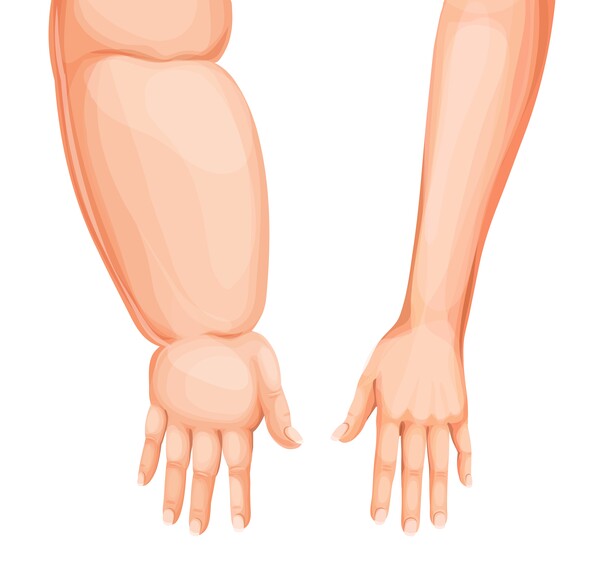Breast cancer surgery combined with chemotherapy is associated with a 1.5 times higher risk of lymphedema than surgery alone, according to Korean medical researchers. Patients who received chemotherapy may also have a risk of lymphedema that increases up to three times more depending on the chemotherapy drugs used.

Lymphedema in the arm. (Courtesy of Seoul National University Hospital)
Seoul National University Hospital announced Tuesday the results of the research team led by Professor Ja-ho Leigh of the hospital's Department of Rehabilitation Medicine and Professor Chun Seong-min of Soonchunhyang University Hospital, who followed up on the risk of lymphedema in patients first diagnosed with breast cancer between 2006 and 2017 for five years and further analyzed it according to whether or not they received chemotherapy.
According to the 2022 National Cancer Registry, breast cancer accounts for 21.8 percent of all female cancers. The primary treatment for breast cancer is surgery, which is often combined with chemotherapy and radiation to prevent recurrence and metastasis. If the lymph nodes are damaged during this process, lymphedema, a swelling of the hands and arms, can occur. In severe cases, the swelling increases and is accompanied by pain and stiffness, leading to physical and psychological problems, which can be prevented by proper rehabilitation from the beginning.
To systematically determine the risk of lymphedema by breast cancer treatment method, the researchers analyzed data from 114,638 breast cancer patients registered with the National Health Insurance Service and the National Cancer Registry. The patients were categorized into the following treatment groups: surgery, surgery plus chemotherapy, surgery plus radiation, surgery plus chemotherapy plus radiation, chemotherapy alone, and chemotherapy plus radiation.
After five years of follow-up, 38.4 percemt of all patients developed lymphedema. The risk of lymphedema was higher in the chemo-alone group (1.58 times), surgery+chemo (1.54 times), surgery+chemo+radiation (1.51 times), and chemo+radiation (1.13 times), compared to the surgery group. There was no significant difference in the surgery+radiation arm.
In other words, the risk of lymphedema was significantly higher in the chemotherapy group than in the surgery alone group, especially when combined with surgery, which increased the risk by more than 1.5 times. The researchers explained that the higher risk of lymphedema in the chemotherapy-alone group may be due to the relatively large proportion of patients with higher-stage disease.
Furthermore, the risk of lymphedema was higher in the total mastectomy group than in the partial mastectomy group, and in the lymph node removal group than in the lymph node-sparing group. In addition, the association between lymphedema and chemotherapy was increased in patients under 50 years of age without complications and over 50 years of age with complications.
The researchers then analyzed the impact of chemotherapy on lymphedema when all other conditions were the same, including age, residence, and stage.
They found that the risk of lymphedema was 1.95 times higher in the chemotherapy group than in the non-chemo group, with the highest risk of lymphedema in the taxane class (3.38 times), followed by antimetabolites and anthracyclines (1.79 and 1.49 times, respectively).
In addition, the risk of developing lymphedema due to chemotherapy was found to be even greater in rural residents and low-income individuals, who are less likely to have early detection and treatment of lymphedema due to poor access to healthcare, and in patients with breast cancer metastasis, who are more likely to have damaged lymphatic systems at the time of diagnosis.
“Based on large-scale data including the entire Korean breast cancer population, it is significant to confirm that patients who receive chemotherapy are at increased risk of developing lymphedema after treatment, and that taxane-based chemotherapy is particularly strongly associated,” said Leigh.
“Breast cancer patients undergoing chemotherapy should practice regular arm circumference measurements, weight management, and active exercise to prevent lymphedema, and this high-risk group should also be provided with appropriate education on lymphedema management and rehabilitation opportunities.”